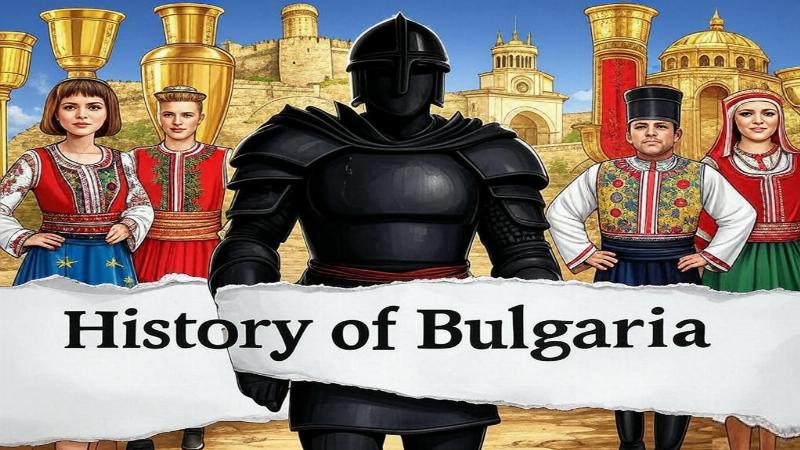Place for ads

Bulgaria, a rugged nation at the crossroads of Europe and Asia, is a land where ancient ruins whisper tales of empires past. Covering 110,994 square kilometers, it sits between Romania, Serbia, North Macedonia, Greece, Turkey, and the Black Sea, its mountains and plains shaping its destiny. Known today for its rose oil, yogurt, and vibrant culture, Bulgaria’s history is a rich tapestry of Thracian glory, medieval might, and modern rebirth. In this article, we’ll journey through Bulgaria’s past, from its earliest days to its contemporary identity, uncovering the milestones that have defined this resilient country.
Bulgaria’s human story begins around 1.4 million BCE, with Homo erectus tools found near Kozarnika Cave. By 40,000 BCE, Neanderthals roamed—caves like Bacho Kiro yield their bones—followed by modern humans crafting flint by 30,000 BCE. The Neolithic era (6000 BCE) brought Europe’s oldest gold treasure at Varna, a sign of wealth and craft.
The Chalcolithic period (4500 BCE) saw settlements like Karanovo thrive, their pottery traded across the Balkans. Indo-European tribes arrived by 2000 BCE, ancestors of the Thracians, who smelted bronze and raised cattle. These early peoples laid Bulgaria’s ethnic and cultural roots, a foundation for its ancient rise.
Place for ads
By 1200 BCE, the Thracians dominated—fierce warriors famed by Homer, their tombs like Kazanlak’s (4th century BCE) dazzle with frescoes and gold. Tribes like the Odrysian Kingdom under King Teres I (5th century BCE) ruled vast lands, trading wine and horses with Greece—Panagyurishte’s golden rhytons tell of their splendor.
Greek colonies like Apollonia (Sozopol) dotted the Black Sea by 600 BCE, while Persia briefly held Thrace in the 5th century BCE. Alexander the Great conquered it in 335 BCE, but Rome annexed Thrace by 46 CE—Plovdiv (Philippopolis) and Serdica (Sofia) became Roman hubs, linked by Via Diagonalis.
The 6th century CE saw Slavic tribes flood the Balkans, blending with Thracians. In 681 CE, Bulgar horsemen under Khan Asparuh crossed the Danube, defeating Byzantium to found the First Bulgarian Empire—Pliska was its capital, a sprawling fortress city. The empire stretched from the Black Sea to the Adriatic.
Christianity arrived in 864 under Tsar Boris I—Saints Cyril and Methodius’ Glagolitic script birthed the Cyrillic alphabet, spreading literacy. Simeon I the Great (893–927) made Bulgaria a cultural titan—Preslav’s Golden Church gleamed—rivaling Byzantium until its 1018 fall to Basil II, the “Bulgar Slayer.”
After Byzantine rule, the 1185 Asen brothers’ uprising birthed the Second Bulgarian Empire—Veliko Tarnovo rose as its heart, its fortress overlooking the Yantra River. Tsar Ivan Asen II (1218–1241) reclaimed lands, defeating the Latins at Klokotnitsa in 1230, while churches like those at Boyana painted Bulgaria’s medieval soul.
The 14th century saw decline—feudal splits and Mongol raids weakened it. Ottoman Turks conquered Tarnovo in 1393—Tsar Ivan Shishman fell, ending Bulgarian rule. Five centuries of Ottoman dominion began, reshaping Bulgaria’s faith, towns, and fields under the sultan’s yoke.
Ottoman Bulgaria became a Balkan breadbasket—Sofia’s mosques and Plovdiv’s bazaars thrived, but heavy taxes and forced conversions to Islam bred unrest. Haiduks (rebels) like Petko Voivoda roamed the Rhodopes, striking Turkish garrisons. The 17th-century Chiprovtsi Uprising failed, but defiance simmered.
The 19th-century National Awakening ignited—Vasil Levski, the “Apostle of Freedom,” plotted revolt until his 1873 execution. The 1876 April Uprising saw 15,000 die—Botev’s poetry rallied hearts, and Russia’s 1877 war freed Bulgaria. The 1878 Treaty of San Stefano birthed a vast Bulgaria, shrunk by Berlin’s revision.
In 1878, the Principality of Bulgaria emerged under Prince Alexander I, vassal to the Ottomans—Sofia became capital in 1879. Full independence came in 1908 under Tsar Ferdinand I, declaring a kingdom. The Balkan Wars (1912–1913) gained Thrace but lost land in World War I—Bulgaria’s German alliance failed by 1918.
Post-war, Tsar Boris III (1918–1943) navigated turmoil—agrarian reforms under Stamboliyski clashed with coups. World War II saw Bulgaria join the Axis in 1941, occupying Macedonia but sparing Jews from death camps. Boris’ 1943 death and Soviet invasion in 1944 ended the monarchy.
In 1946, the People’s Republic of Bulgaria formed—Georgi Dimitrov’s communists abolished the monarchy, executing royals. Soviet-style industry rose—Pernik’s steel and Dimitrovgrad’s chemicals—while collectivization crushed peasants. Todor Zhivkov ruled from 1954–1989, a loyal Moscow ally.
The 1980s saw stagnation—Zhivkov’s 1984 “Bulgarization” forced Turks to adopt Slavic names, sparking exodus. Protests in 1989 toppled him—communism fell, and Bulgaria’s first free elections in 1990 birthed democracy, though economic chaos followed.
Today, Bulgaria’s 6.8 million people embrace EU membership since 2007—Sofia’s metro and Plovdiv’s tech hubs signal progress. NATO joined in 2004, but corruption and emigration challenge growth—rose oil and wine exports thrive. Rumen Radev’s presidency (2017–present) navigates populism and reform.
Culture shines—Thracian gold, Orthodox chants, and kukeri dances endure. Tourism booms—Bansko’s slopes, Nessebar’s coast—but rural depopulation lingers. Bulgaria balances its past with a European future, its spirit unbroken.
Bulgaria’s history is a Balkan odyssey—from Thracian tombs to imperial crowns, Ottoman chains to modern wings. Its hills hold ancient secrets, its cities hum with promise. As Bulgaria strides forward, its past fuels a legacy of grit and grace.
Place for ads